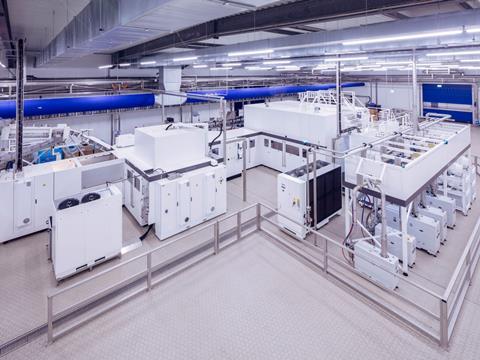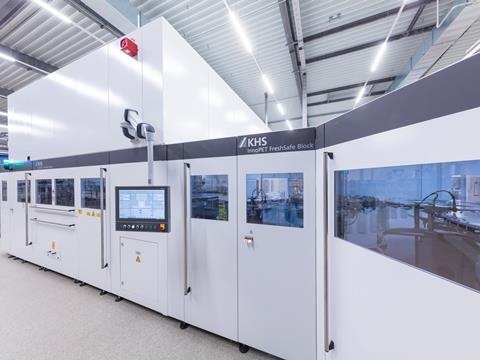
In the evolving landscape of sustainable beverage packaging, the enhancement of PET bottles through the use of specialized coatings has emerged as a key focus. To learn more about these, Philipp Langhammer, Product Manager Barrier technology at KHS Group, tells us more.
I’d like to start by taking a look at coatings for PET bottles as a whole. How do they work, and why are they sometimes required?
The so-called Plasmax technology, which is only offered by KHS in the beverage sector, serves to preserve product quality and specifically protects the product against oxygen pickup, loss of carbon dioxide, loss of flavour and loss of vitamins.
In addition, it extends the shelf life of the bottled beverages, which in turn allows for higher utilization of PET filling lines, as a longer shelf life enables production even before a peak season.
At the same time, the quality costs for bottles returned due to expired shelf life are reduced. As a result, the distribution chain from production to the consumer is extended and market penetration increases.
Lightweighting beverage bottles to reduce the use of PET is very relevant for many markets, both for sustainability reasons and in terms of cost reduction. However, the weight reduction results in thinner walls and higher CO2 retention or increased oxygen input.
Therefore, the shelf life is reduced. Our SiOx coating on the inside of the PET bottle significantly reduces the permeation of gases (oxygen ingress, CO2 loss) and thus greatly extends the shelf life.
Material barrier solutions are often designed as a composite of different materials, PET plus barrier. These additives make them more difficult to recycle than a normal PET bottle as despite being subjected to elaborate processes the various materials cannot be separated during recycling and cause discoloration of the recyclate, for example.
This complicates pooled recycling with the traditional single-use PET containers in the deposit system and makes global bottle-to-bottle recycling, which requires 100 percent pure rPET, practically impossible.
Now let’s take a look at KHS’ solutions in this field. What is FreshSafe PET, how does it work, and how does it perform in terms of recyclability?
The bottles are coated using the PICVD (Plasma Impulse Chemical Vapor Deposition) method, a process first used in the pharmaceutical industry. In this process, a reaction gas mixture is introduced into the PET bottle in a fine vacuum, which is then subsequently transformed into a plasma state by applying microwaves.
In this state, SiOx or chemically pure glass is deposited on the inside of the bottle. The inner glass coating is transparent and has a thickness of less than 0.1 μm. It is therefore flexible, chemically bonded to the inner wall of the bottle and cannot peel off. It is only in the recycling stream that the SiOx is hydrolyzed by the caustic washing solution.
Thanks to this special feature, the FreshSafe PET bottle from KHS is 100 percent bottle-to-bottle recyclable. This has also been confirmed by trade associations such as the European PET Bottle Platform (EPBP) and the Association of Plastic Recyclers APR (USA).
In the evolving landscape of sustainable beverage packaging, the enhancement of PET bottles through the use of specialized coatings has emerged as a key focus. To learn more about these, Philipp Langhammer, Product Manager Barrier technology at KHS Group, tells us more.

In the context of deposit return schemes, do you believe that FreshSafe PET can assist with the recycling of bottles which might otherwise not be included in these schemes?
Definitely. To ensure the protection of beverages, PET bottles may contain additives with oxygen absorbers or a passive CO2 barrier such as nylon or EVOH. As mentioned, these additives make pooled recycling with the traditional single-use PET containers in the deposit system difficult and bottle-to-bottle recycling, which requires 100 percent pure rPET, impossible.
Our eco-friendly alternative, on the other hand, uses a barrier made of chemically pure glass. The wafer-thin coating is fully recyclable. During the recycling process, the coating is hydrolyzed using hot caustic and thus removed from the inner bottle wall. It then goes into solution and the pure PET can be collected by type.
How does the solution perform from a carbon emissions perspective?
Concrete figures are not yet available. In general it can be said that PET bottles are much lighter than glass bottles. This has a positive impact on the amount of CO2 emitted by trucks as fewer bottles or lower load weights mean less gas consumption. Plastic bottles are also unbreakable, flexible and recyclable.
Thanks to the recyclability of our solution, we promote closed material cycles in which PET bottles are collected and new bottles are processed again. Plasmax technology can also be used for bottles made of 100 percent recyclate. With our solutions, we support the European Strategy for Plastics, which requires all plastic packaging to be reusable or recyclable by 2030.
What can we expect from KHS in the future in terms of PET bottle coatings?
Are there any specific coating trends that you think will have an important impact on the market in the near future?At Anuga FoodTec 2024, we will be presenting the latest generation of our Plasmax coating technology, which offers even better coating quality, more flexibility, higher evacuation capacity and more PET savings. In addition, the technology offers greater design freedom, lower maintenance costs and is therefore even more efficient.
The trend towards smaller pack sizes under 300 ml is often accompanied by the use of metal cans instead of PET due to the better barrier. The large surface in comparison to the small volume has often been an argument against the use of PET.
In this respect, the coating has the potential to become a game changer to reduce the carbon footprint and introduce PET bottles in small pack sizes with a long shelf life. To date, the circular economy has only worked with clean and pure rPET. Every barrier placed on a package must be fully recyclable and applicable to 100% PCR for a circular economy.










